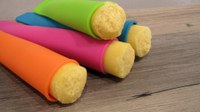Prairie Fare: How to Stay Cool and Hydrated in the Heat
(Click an image below to view a high-resolution image that can be downloaded)
By Julie Garden-Robinson, Food and Nutrition Specialist
NDSU Extension Service
I figure my distant ancestors spent most of their time in cold climates with little exposure to the sun. They probably slogged through snowdrifts to reach their recreational icebergs, where they could dip their toes in freezing water. When the sun came out, they probably retreated to cold, dark caves.
Therefore, I think I have the genetics to tolerate cold better than heat. I know how to layer clothes to tolerate the cold. You can remove only so many articles of clothing in public.
Lately, the hot weather has made me want to retreat to a cold cave or dip my toes in ice water.
I spent a week in Washington, D.C., in mid-July, when the temperature climbed above 100 degrees and the humidity was equal to a sauna. I was guzzling water constantly, and I still couldn’t stay fully hydrated.
“I can’t handle heat!” I exclaimed to my patient trip companions as we walked on the white-hot marble and concrete around the national monuments. My face was red as a tomato and my hair was wet from perspiration. I was not photo-ready.
Irritability is the first sign of dehydration. They probably realized it, too, by my example. We stayed inside highly air-conditioned buildings most of the time. At least they didn’t have to carry me inside or call an ambulance.
When I returned home, a heat wave hit the Midwest. Where’s my cold cave?
Extreme heat can have dire health consequences on every organ of your body. Water makes up about three-fourths of the body weight of infants, making them very susceptible to dehydration. On average, an adult’s weight is about two-thirds water.
Even mild dehydration has immediate effects. Besides feeling thirst, you might get a headache and swollen feet, and feel sluggish.
Staying well hydrated is especially important for heart health. When you become dehydrated, your heart has to work harder to push the thicker blood throughout your body.
Maintaining hydration in your body helps with management of your body temperature. Water is essential to protect your tissues and keep your joints lubricated. Staying adequately “watered” at all times helps your body rid itself of wastes.
Thirst is one gauge for hydration level but not necessarily the best one. As we get older, our “thirst meter” usually doesn’t work as well. Some medications and medical conditions also can affect how we perceive thirst.
A better gauge for hydration level can be assessed in the privacy of your bathroom. Yes, the color of the urine we produce is a good indicator of hydration level, unless you are taking medications that color the urine.
Pale yellow (straw colored or weak lemonade-colored) urine indicates you are well hydrated. As your urine gets darker yellow, you should rehydrate soon. If your urine reaches the point of dark amber (orange-yellow), you are probably severely dehydrated and should contact your health-care provider immediately.
Staying hydrated is necessary for survival. We can survive without food longer than without water. In fact, we would survive only a few days without water.
In hot weather, stay inside as much as possible, especially during the heat of the day. Heat exhaustion or heat stroke can be life-threatening. If you are working outside, drink water often and wear lightweight clothing. When you get inside, take a cool bath or shower and rest.
Drink plenty of fluids and eat water-rich foods such as fruits and vegetables. Many fruits and vegetables are 85 to 95 percent water by weight.
Keep in mind that alcohol-containing beverages, such as beer, are not as hydrating as water. You probably do not need a “sports drink” to recover, either. Consume a healthful meal to replace lost electrolytes (minerals lost in perspiration). Chocolate milk often is used as a workout recovery or sports drink because it provides fluid, electrolytes and carbohydrate.
Here are some additional tips about staying hydrated that are adapted from the Centers for Disease Control and Prevention:
- Carry a water bottle for easy access when you are at work or running errands.
- Freeze some water in freezer-safe water bottles. Take one with you for ice-cold water all day long.
- Choose water instead of sweetened beverages. This also can help with weight management. Substituting water for one 20-ounce sugar-sweetened soda will save you about 240 calories.
- Choose water when eating out. Generally, you will save money and reduce calories.
- Add some flavor to your water by adding a wedge of lime or lemon to it. Or try adding some cucumber slices or strawberries. This can improve the taste and help you drink more water than you usually do.
Stay cool and hydrated during the warm days of summer. Because we don’t have any icebergs handy to lounge upon, here’s a frozen treat to enjoy. Milk and juice provide nutrients as well as fluids, and this treat has just 45 calories. It might remind you of a childhood summer treat.
Orange Dream Creamsicles
1/2 c. vanilla soy milk (or regular milk)
1/4 c. frozen orange juice concentrate
In a blender, blend soy milk and orange juice concentrate. Place in Popsicle molds and freeze.
Makes four servings. Each serving has 45 calories, 0.5 gram (g) fat, 1 g protein, 9 g carbohydrate, 0 g fiber and 15 milligrams sodium.
(Julie Garden-Robinson, Ph.D., R.D., L.R.D., is a North Dakota State University Extension Service food and nutrition specialist and professor in the Department of Health, Nutrition and Exercise Sciences.)
NDSU Agriculture Communication - July 21, 2016
| Source: | Julie Garden-Robinson, 701-231-7187, julie.garden-robinson@ndsu.edu |
|---|---|
| Editor: | Ellen Crawford, 701-231-5391, ellen.crawford@ndsu.edu |



